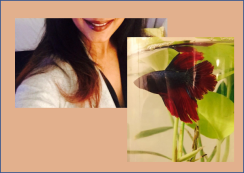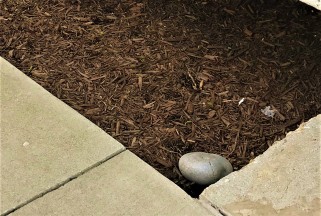As I arranged his mane on a bed of lettuce leaves, I felt a lump of emptiness in my stomach. He was so tiny. The resplendent sheen of life had left his fins and his eyes, these were uncharacteristically clouded and colourless, quite like the overcast sky on that Sunday morning. Gentle drops of rain eased the thick mulch in the flower-bed where I arranged his final resting place. The drizzle masked some moisture in my eyes as I covered the small creature. Somehow, we had to do this right, to find him a resting place after two years as a member of the family; Fishy (aka Jet) was gone.

After his weekly bath every weekend, he would dash about excitedly to take in the fresh nourishment for a while, then slowly letting out small bubbles of happiness, he would pick a leaf and lay gently on it as he slept, evidently exhausted by the excitement. His rhythms were reassuring. One could spend time watching him swim about or sink to the bottom, snatch at bloodworm snacks or his regular meal as if these were live creatures. Only this Sunday, his bath got the better of him.
His connections with our world were evident on occasion. Sometimes he would startle to sudden sounds and at other moments, we could have sworn that he was watching the moving figures on a favourite TV show. I like to believe he enjoyed the ambient sounds of a well-done audiobook the best. When the apartment was really, really, quiet, gentle clicking sounds could be heard as he played around in his underwater forest. Sometimes his stillness would cause alarm, he would be so unmoving that one had to tap the bowl to check if everything was okay. The knock would instantly wake him up and to reassure us, he would start sashaying around the foliage to check if a new lot of worms had been deposited for him to catch.

They say that pets and owners tend to resemble each other, right? Well Fishy (aka Jet) certainly proved the point. I could see some resemblance between his burgundy fins and the streaks of colour that his mum was wearing on her thick hair when she brought him home. Fishy was a Betta Fish, bright, beautiful and bubbly. He lived in a delicate, reasonably self-sufficient balance with his water-plant in a glass home. When he was alone for a while, there was a wholesome meal that could keep him nourished for several days. Fishy was easy to care for and beautiful to be with; an integral part of this home where he’s left a small but significant emptiness where he once lived. By now, creatures not unlike the ones on which he survived may have got to him in a replay of the cycle of life.

As he lay still in his bowl last Sunday morning, we checked repeatedly to see if there was any sign of life. Tap, tap, tap……… and then frantically again, tap, tap, tap!!! “He’s gone, Ma” my son said. Although the position was peculiarly bent and lifeless, I just could not believe that his life was over. I guess it isn’t ever easy, even when we know that the life-span has been lived out fully. The moment it happens seems so to bring home the full-blown realization of the linearity of time, there is no going back from here. When we realized he was gone, we were faced with the next question: How and where would we send him off? We had to do something special, after all, he was family!

It is so easy to form an attachment, and we had to find a way of doing this meaningfully. The idea of lettuce leaves seemed sort of comforting, so slowly lifting his lifeless body from the water, we proceeded to the flower-bed just under the balcony. Next to his grave, we placed a stone to mark his space for a while longer till he became a part of the spring blossoms.

Commentary
The passing of Fishy’s life raised many thoughts about life, death, living on, remembering for us as well as our team. Let me try to put down some of the themes that came up in our exchanges.
Living among other living beings
In a recent tweet, the World and Science[1] forum reminded us that “If the history of Earth was compressed to a single year, modern humans would appear on December 31st at about 1100 pm”. In relative terms, life as we know it today is insignificant. Yet we live with a belief in our self-importance and act as if we will live forever. Mortality is something we are not comfortable with, and yet, it remains the final and most certain truth.
In our past, humans have always lived in close communion with other living beings. More recently in urban environments, the permissible formats for that interface have become limited. The seamless engagement with plants and animals that rural households facilitated is no longer possible, and for most of us living in cities, we must travel long distances to experience ‘nature’. Whether or not we will encounter animals is decided by the rules of the urban environments in which we live. In some ways, the convenience of city life has inconvenienced animals and plants. In such situations, having pets provides us with a possible solution. It is true that living with animals as companions have many known benefits; yet, some of us find it uncomfortable or impossible to live comfortably with them, either because we don’t like the idea or because we’re afraid of becoming attached. In an interesting aside, I was informed by Shraddha Kapoor that this is the first time the White House has been without a first pet!!!
Living, dying and living on
About lives that we have loved and lost, lives that ended to soon, lives that lived out their span, lives that are stuck somewhere in between, I find some reassurance in being Hindu. Different religions have different conventions regarding life and the treatment of its end. From preserving the human form in a burial to giving it away in the Tower of Silence[2], the solutions to the lifeless human body are varied. Most of us are not comfortable talking about this, especially with our children. When and how do we introduce conversations about death? Do we allow children to be part of the experiences with, or do we tend to ‘protect’ them? In rural homes, children are in constant contact with the realities of life and death through the close engagement with nature. Not so in modern homes where talk about death is a silence zone and the shrinking family size reduces encounters with natural events. Slowly, we have become isolated from the reality of the life-cycle.
Thus the separation of different domains of life is a direct outcome of urbanization,, leading to a carefully protected and cultivated version of reality. This reminds me of Buddha’s story. As a young Prince predicted to become a sage who would find the answer to human suffering, Siddharth’s world was frantically protected by his royal parents. He was only permitted to experience of joy and beauty through closely guarded supervision. When, for the first time he accidentally saw illness and suffering, it was a point of no return. Prince Siddharth[3] was so profoundly impacted by this vision that he was unable to live a life of luxury and subsequently renounced all worldly desires. Perhaps there is a life lesson in this story about keeping our lives too protected, our children too falsely ‘happy’, too distant from death and its discourse. In this regard, the notion of karma and reincarnation in Hinduism provide some reassurance for me.
The ‘living will’: Dying with dignity
Sometimes, when people are stuck between life and death, we live in hope of their survival. Euthanasia, that is permissible for animals is limited for humans. Few societies permit people the choice to die with dignity. In this regard, the recent ruling by the Supreme Court of India was path-breaking when on March 9th 2018, a decision was reached to allow people with the choice. To prevent its misuse, strict guidelines have been provided to safeguard citizens, but as Indians, we now have a choice that we can declare in a ‘living will’, to choose to opt out of living death[4]. I thank Shraddha for this reference to this article as well as Atul Gawande’s position on the matter of dignified survival and care of the elderly. Gawande[5], the renowned American surgeon, author and researcher, lauds this decision and urges other nations to follow the lead that India has taken on this issue. ‘Being mortal’[6] is an outstanding book that he has written about growing old and health care of the elderly.
Purification by fire
Fishy was family and we had to send him away well. Several thoughts ran through our minds. Remembering others we had seen passing, thoughts about funeral rites came rushing in. Hindus cremate their dead, but not all living beings are committed to purification by fire. It is only the adult, the ordinary human, who is subjected to this ritual. The main argument is that attachment to one’s body is seen as a burden, and any form untainted by karma need not undergo cleansing by fire, Devdutt Pattanaik informed me. It is believed that if the mortal remains are not turned into ash and then dispersed in flowing water, the ordinary human soul will linger around the physical space because of the affection for its form that develops over time, it is assumed. Indu Kaura reminded me that the cycle of separation is completed after 13 days, the time that it is believed to take for the soul to fully separate from its form and family. The human form is likened to clothing, something that can and should be discarded when its cycle is over. The real energy is independent of form, a former corporate trainer and now spiritual teacher Barkha Khandelwal says in response to questions from Pooja. Funerals are our ways of expressing the loss of the utility of a person, their place in our lives, continuing that this is the reason why funerals of the elderly are peaceful in comparison with those of younger people. We are a self-loving species, and that narcissism needs to be overcome. This attachment, to loved ones, to ourselves and objects, is something we will continue with in the next post as well. Death is a cessation of all attachments, real and imagined!
Pure souls
There is as I mentioned, an exception to the convention of cremation that is applicable to souls that are believed to be pure and unattached to their bodies: Children and saints are not cremated. They can easily discard their bodies as they have not yet formed any attachments, or in the case of saints, have moved beyond the desires of ordinary people. Children and saints are buried because there is no danger of lingering close to the body. This is not a matter that comes up in ordinary conversations in family life; it is something that one learns, painfully, if and when there is a need.
Fishy was like a child, he swam right out of his body in a flash and thus, we decided that he could be buried, he could be seen as a ‘pure soul’, unattached to its form. The burial and the stone-marking was something we needed to do, to attempt to fill our feelings of emptiness and loss. To think about him as a Hindu is sort of reassuring. It is comforting to believe that he has already taken his place in some other home without looking back. Somewhere in the beautiful wide world of life and love and belonging, Fishy lives on!
Links:
[1] https://twitter.com/WorldAndScience/status/973710526520987648
[2] https://en.wikipedia.org/wiki/Tower_of_Silence
[3] https://www.biography.com/people/buddha-9230587
[4] https://timesofindia.indiatimes.com/india/in-landmark-decision-supreme-court-allows-passive-euthanasia/articleshow/63228731.cms
